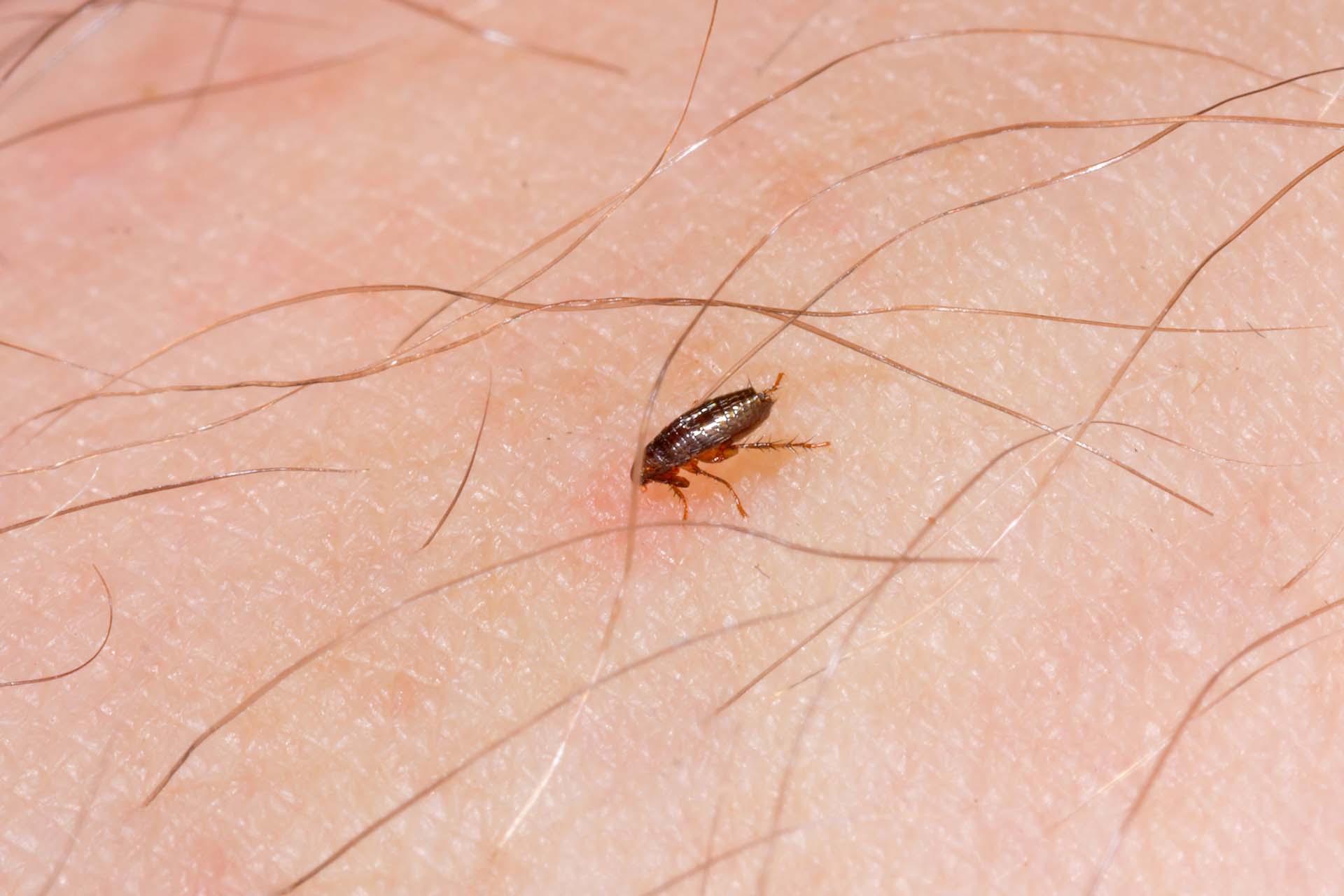Flea Control
Your Guide to Understanding and Combating Fleas
Experiencing an unusual amount of scratching from your pet or spotting tiny jumpers on your carpet can signal an unwelcome flea presence in your home. Fleas, while small in size, pose a significant challenge due to their complex lifecycle, making them a formidable foe for both homeowners and pets. This comprehensive blog article aims to arm you with the knowledge to identify, prevent, and tackle flea infestations effectively.
In the UK, we’re mostly confronted by the cat flea, dog flea, and occasionally the human flea—each capable of causing a range of issues. From the irritation caused by flea bites to the potential health risks they pose to both pets and humans, understanding the appearance of fleas and their bites is vital. Recognising the early signs, such as excessive pet grooming or bites on your own skin, can help you act before an infestation takes hold.
Prevention is just as crucial as treatment, involving regular pet care, home cleanliness, and environmental management. However, should fleas still find a way into your home, knowing how to effectively eliminate them is key. From DIY methods to professional pest control interventions, we cover the essential steps to free your home from these pesky intruders. And if you find the battle against fleas daunting, iX5 Pest Control stands ready to assist, providing expert services to ensure your living space is comfortable and flea-free.
The Flea Menace in the UK
Fleas are ectoparasitic insects that prefer the blood of mammals and birds, with about 2,500 species globally. In the UK, the cat flea, dog flea, and the rare human flea are prevalent. These tiny pests can choose any warm-blooded animal as their host, causing distress and health risks.
The Risks of Flea Infestations
While fleas in the UK don’t commonly spread diseases, their bites are intensely irritating and can lead to skin issues or exacerbate respiratory conditions. For pets, the discomfort is significant, potentially leading to allergic reactions or, in severe cases, anaemia.

Flea Control
What Do Fleas Look Like?
Recognising fleas is the first step in confirming an infestation. Here’s what to look for:
Size and Colour
Fleas are tiny, about 2-3 mm long, and appear as dark reddish-brown insects to the naked eye. Their small size often requires a magnifying glass to see clearly.
Body Structure
They have a hard, flat body that is laterally compressed, allowing them to move easily through animal fur. Adult fleas are wingless but possess powerful legs designed for jumping long distances.
Legs
Fleas have six long legs, with the hind pair well adapted for jumping, propelling them up to distances of over a hundred times their body length.
Movement
Fleas are known for their rapid, high jumps, which is often a visible giveaway. You might notice this when observing your pet or a flea-infested area.
What Do Flea Bites Look Like?
Flea bites have distinctive characteristics, and recognising them can help you determine if you’re dealing with a flea infestation:
Appearance on Skin: Flea bites usually appear as small, red bumps, often in groups of three or four or in a straight line. Unlike mosquito bites, these tend to remain small in size. However, we all react differently to all insect bites so the appearance of bites is not definitive in itself.
Location of Bites: Fleas often bite people around the ankles and lower legs, but if you have been in close contact with an infested pet, you might find bites on your arms or other areas of the body.
Reaction to Bites: The bites are typically very itchy, and there may be a halo around the bite centre. Some individuals may have a more severe reaction, with larger red, raised, and painful welts.
Secondary Symptoms: With excessive scratching, bites can become sore or infected. In cases of sensitivity or allergic reaction, you might also notice hives or a rash near the affected area.
Strategies for Recognising and Preventing Flea Infestations
Recognising the early signs of flea activity can prevent a full-blown infestation. Here’s what to look out for and how to maintain a flea-free home:
- Monitor your pets for unusual scratching, biting, or licking. These actions are often the first indicator of a flea problem.
- Regularly inspect pet resting areas, carpets, and furniture for signs of fleas or flea dirt. This proactive step is especially important in warmer months when flea activity spikes.
- Use vet recommended flea prevention treatments on your pets routinely. Even if no fleas are present, preventive measures can stop infestations before they start.
- Frequent vacuuming, particularly in areas where pets spend time, can remove flea eggs and larvae from carpets and upholstery. Dispose of the vacuum bag immediately to prevent any fleas from escaping back into your home.
- Wash pet bedding, cushions, and any fabric your pet has contact with in hot water weekly. This kills any flea eggs or larvae and reduces the likelihood of an infestation.
- Maintain your garden and outdoor spaces to deter wildlife that may carry fleas. Keep grass cut short and remove debris where fleas might hide or lay eggs.
- Flea repellent products may have some impact in helping prevent flea activity in your home or on your pets, but are not always effective.
By integrating these preventive measures into your routine, you can significantly reduce the chances of fleas taking hold in your home and on your pets.

Flea Control
Identifying the Signs of a Flea Infestation
A flea infestation can often be identified by several tell-tale signs that indicate their presence in your home:
Persistent Scratching and Grooming by Pets: If your pets are constantly itching, licking, or biting their fur, it may be a sign that fleas are present.
Flea Droppings: Also known as ‘flea dirt’, these look like small black specks in your pet’s coat. If placed on a wet paper towel, flea dirt will spread out like a small blood stain.
Flea Bites on Humans: Flea bites typically appear as small, red, and raised spots on the skin. They are often found around the ankles and legs due to fleas jumping from carpets and furniture.
Visual Confirmation: The most definitive sign of a flea problem is seeing the fleas themselves. They are small, dark brown insects that can jump long distances and are occasionally seen on pets, carpets, or furniture.
Eggs and Larvae: These may be found in pet bedding, carpets, and anywhere pets spend time. Flea eggs look like tiny white specks, while larvae appear as small, worm-like creatures.
Changes in Pet Behaviour: If your pet is restless or seems agitated more than usual, it may be due to flea activity. In severe cases, pets may also show signs of weight loss or lethargy.
If you notice any of these signs, it’s important to act quickly to address the problem before it escalates.
Effective Strategies for Eliminating Fleas
When it comes to eliminating fleas, thoroughness is key. Begin by vacuuming all carpets, furniture, and anywhere your pet frequents to remove fleas and their larvae. Wash all bedding and soft furnishings in hot water. For persistent infestations, use a combination of insecticides and insect growth regulators as recommended by pest control professionals. These treatments target fleas at every stage of their lifecycle, ensuring comprehensive control of the infestation. Remember, after treatment, avoid vacuuming or washing treated areas for at least two weeks to allow the insecticide to work effectively. If you’re uncertain about tackling the problem yourself, iX5 Pest Control’s experienced technicians can help ensure fleas are completely removed from your home.
Professional Pest Control: The Best Defence Against Fleas
For a complete flea control solution, professional intervention is often the best course of action. Trained technicians use professional-grade insecticides and growth regulators to halt the flea lifecycle, providing long-term relief.
At iX5 Pest Control, we help you to completely eradicate fleas with safe, effective treatments. Don’t let fleas take over your home; contact iX5 Pest Control for expert assistance and regain the comfort of your living space.
We offer Flea Pest Control services for domestic premises and businesses in Northampton, Daventry, Rugby, Market Harborough, Towcester, Brackley, Wellingborough, Kettering, Corby, Olney and all of the surrounding areas. Our team of specialists are available both evenings and weekends at no extra cost. Should you require assistance call us on 01604 328545, email [email protected] or use our simple contact form

